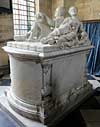For this church:    |
|
 The Lexington The Lexingtonmonument |
The south chancel chapel dates from the 18th century and was probably built as a funerary chapel to the Lexingtons. It contains monuments to Robert Sutton Lord Lexington (d1723) and Lady Lexington (d1703). The monument is made of marble and on top are effigies of the Lexingtons, reclining back to back.
Lord Robert Lexington was owner of Averham and Kelham. His father was created Lord Lexington by Charles I in 1646. Robert Lexington served William III and Queen Anne as an envoy and ambassador. An inscription on the monument describes the achievements of Lord Lexington in these roles. More information is available on the Lexingtons here: 3rd Duchess of Rutland and Lexington Memorial Kelham
Lord Lexington’s son was also interred in Kelham. He died in Madrid while his father was an ambassador there and his body was transported back to Kelham, concealed in a bale of cloth.
In the chapel another tablet commemorates Thomas Lord Manners (d1842). He served the Prince of Wales and King George III as Solicitor-General. He became a Baron of the Exchequer, Peer of the realm, and then Lord High Chancellor of Ireland.
His brother, a former rector of St Wilfrid’s, became Archbishop of Canterbury in 1805. Charles Manners-Sutton was rector of the parish of Averham with Kelham, progressed to Bishop of Norwich in 1792, also became Dean of Windsor, and then rose to the position of Archbishop.
Thomas Herring, Archbishop of York, toured the diocese in 1743. A visitation report includes details of St Wilfrid’s. The parish held 40 families and there were no dissenters. There was also a charity school in the parish. The Rev James Naish resided in his parish and had no curate.
In 1764, with the visitation of Archbishop Drummond, there were only 10 families in the parish and no dissenters.
According to Bailey's Annals, in 1844 the church at Kelham was 'new roofed, and completely renovated.' However, no corroborating evidence for this claim has been found.
The 1851 census listed a population of 167 for Kelham. The average congregation in morning services was 70 and in the afternoon 90. The average number of Sunday School scholars in mornings and afternoons was 30.
St Wilfrid’s was restored by Charles Hodgson Fowler during 1872-3 and reopened on 20 January 1874. White’s Directory of Nottinghamshire estimates that the restoration cost about £800. According to the Nottingham Journal of 23 January 1874 J H Manners Sutton 'restored nave and aisles of the church almost entirely at his own cost' and the rector 'restored the chancel at his own entire expense.' As part of the restoration the windows were re-glazed, and oak stalls put in. A new pulpit, lectern, litany desk and altar table were installed. A classical arch leading to the south chancel chapel was replaced by a gothic one. Also turreted stonework was added to the outside of the nave, and side aisles.
In c1912 Sir Edward Hoskyns, Bishop of Southwell, toured the diocese. The visitation records name the rector as J Cyril Walker. The church was able to accommodate 150 people.
Efforts to raise funds for restoration began again in 1963.
In 1982 Newark District Council contributed a significant sum to save the church tower from collapsing on the roof.






